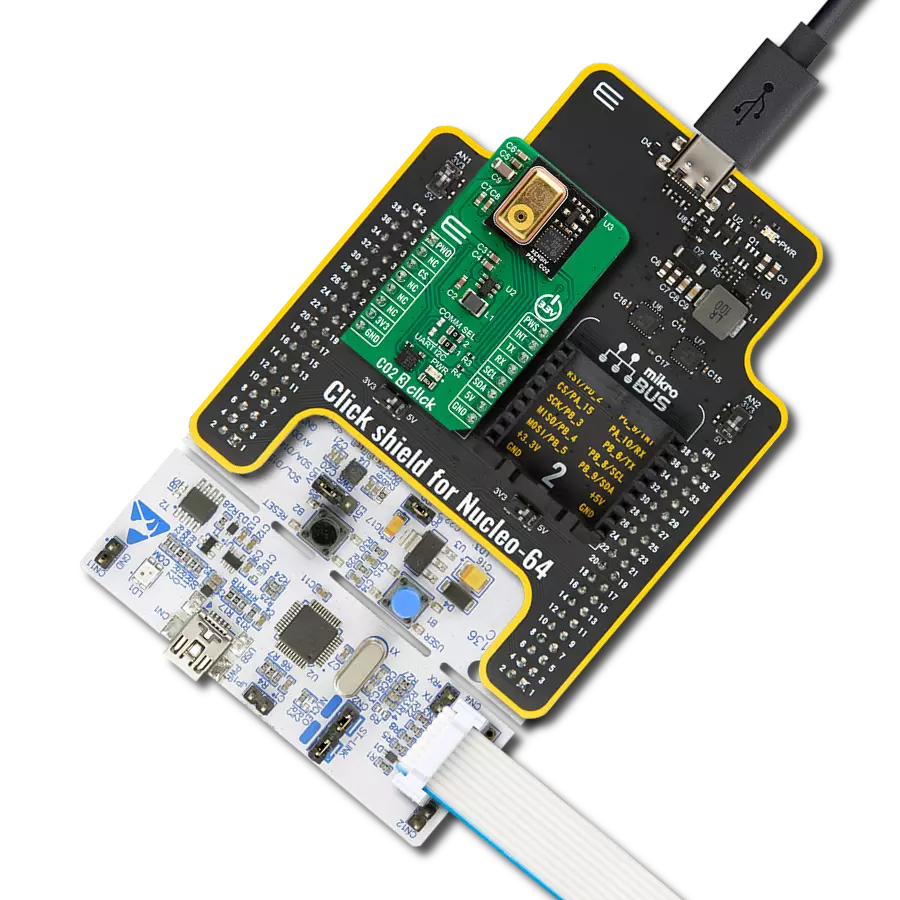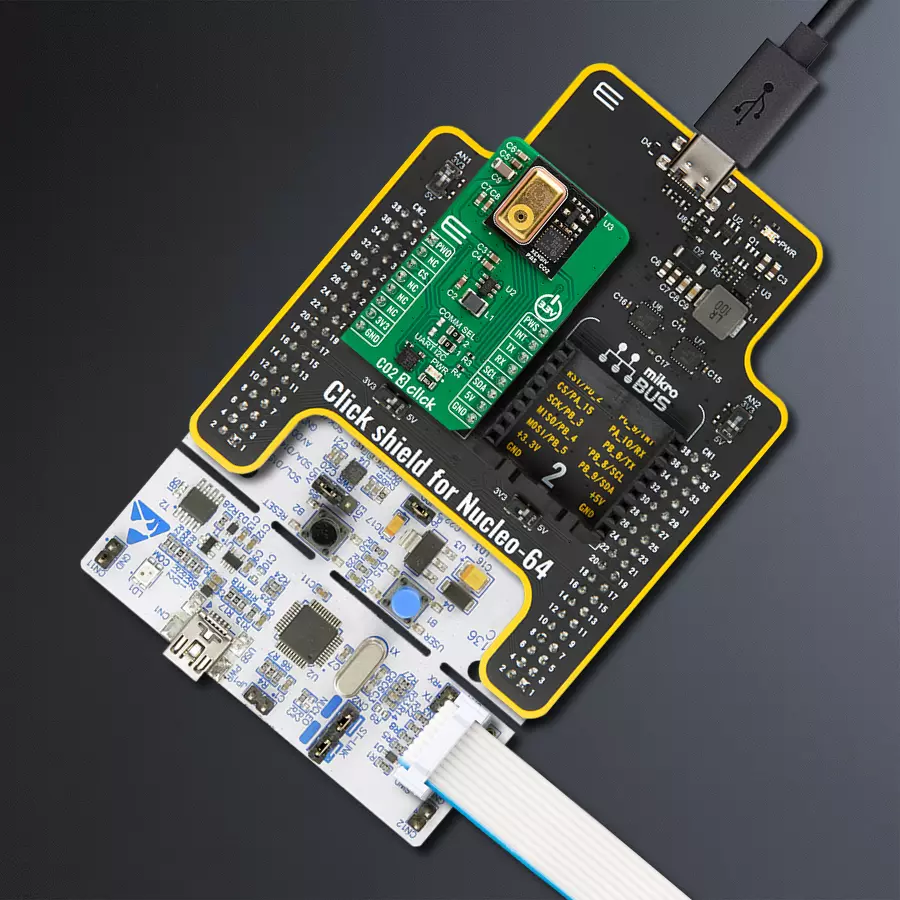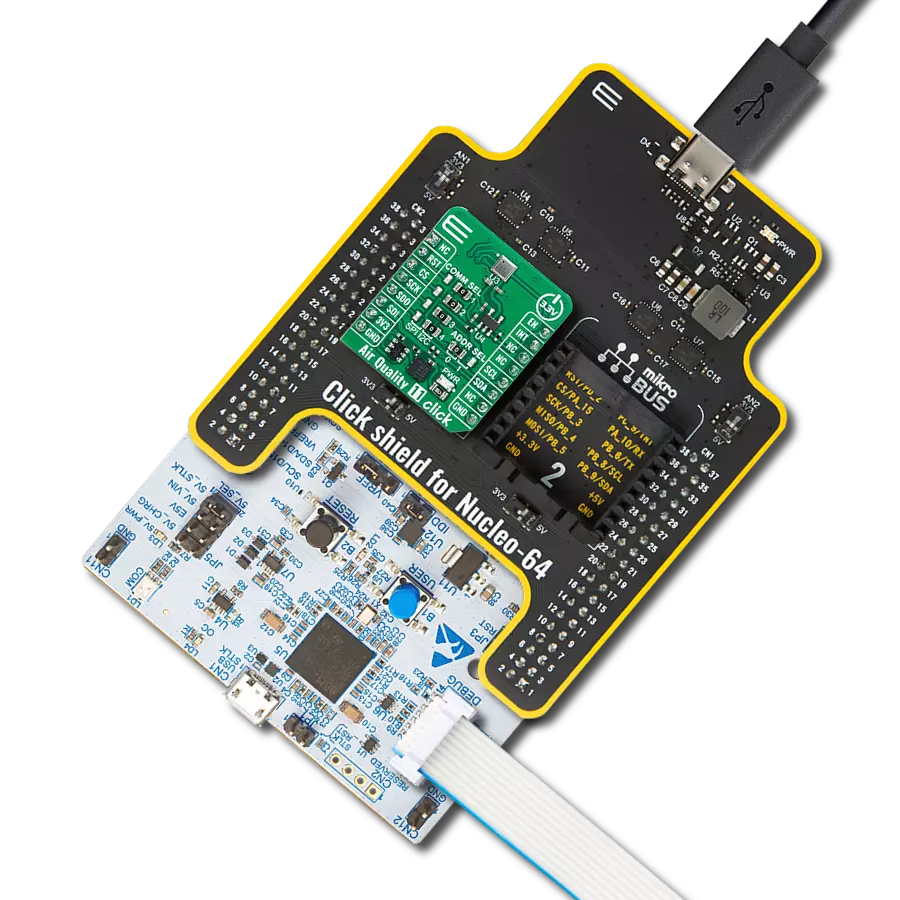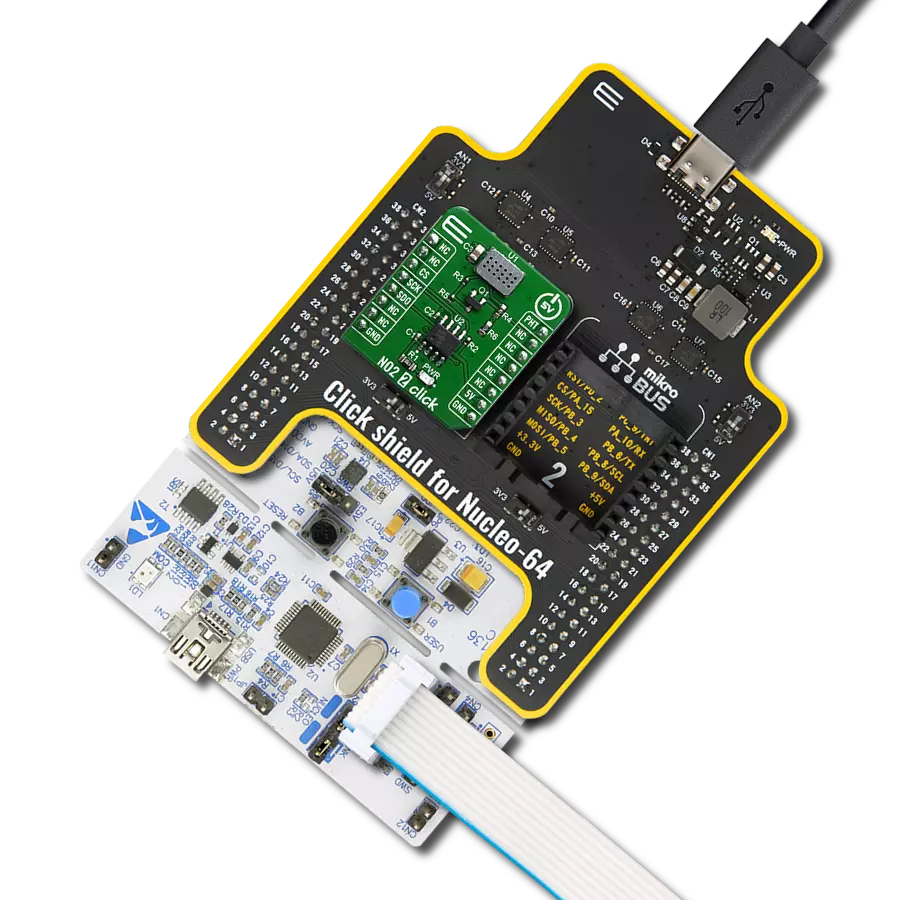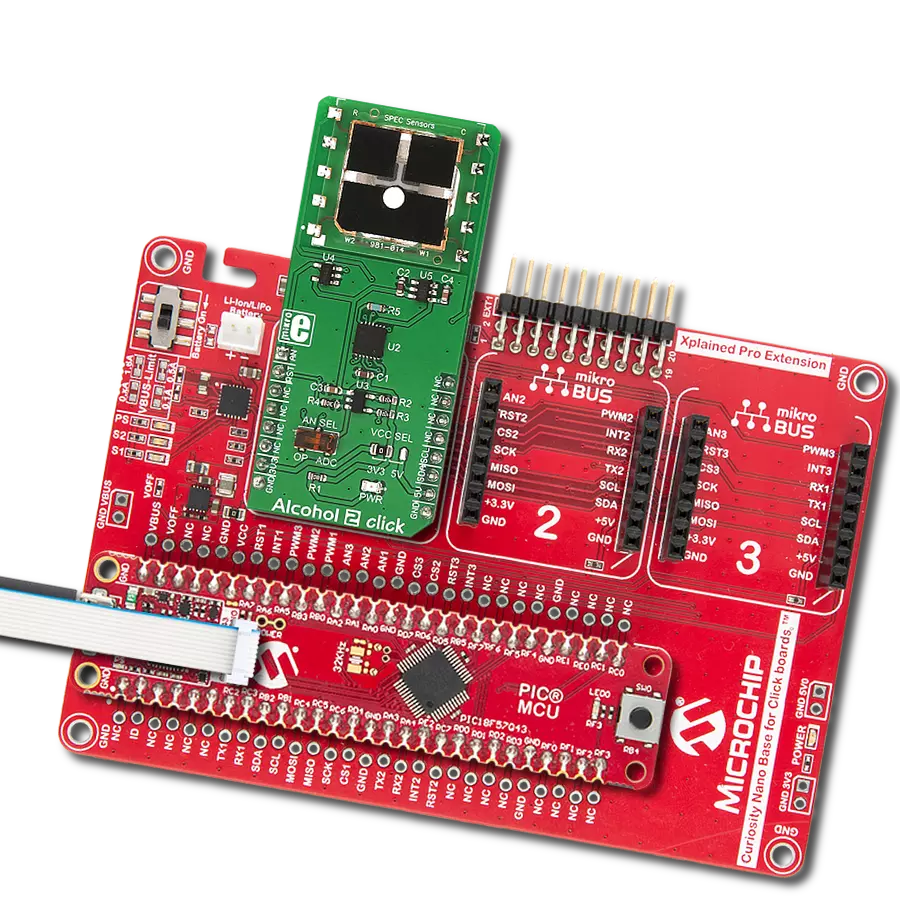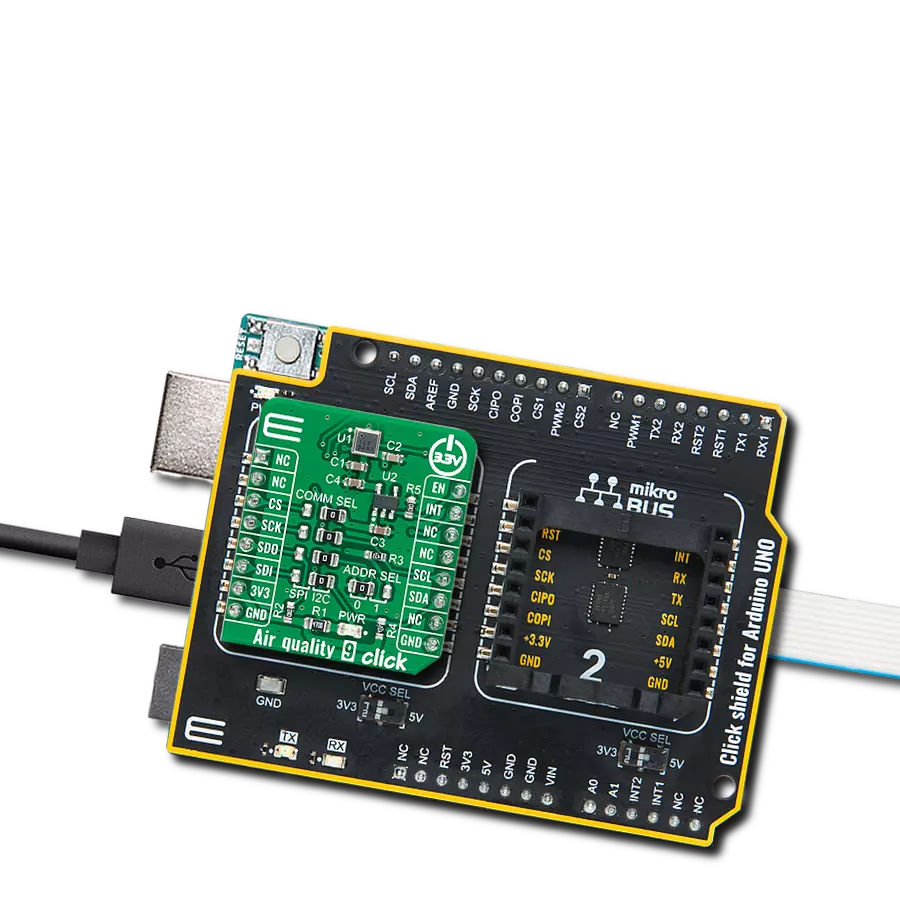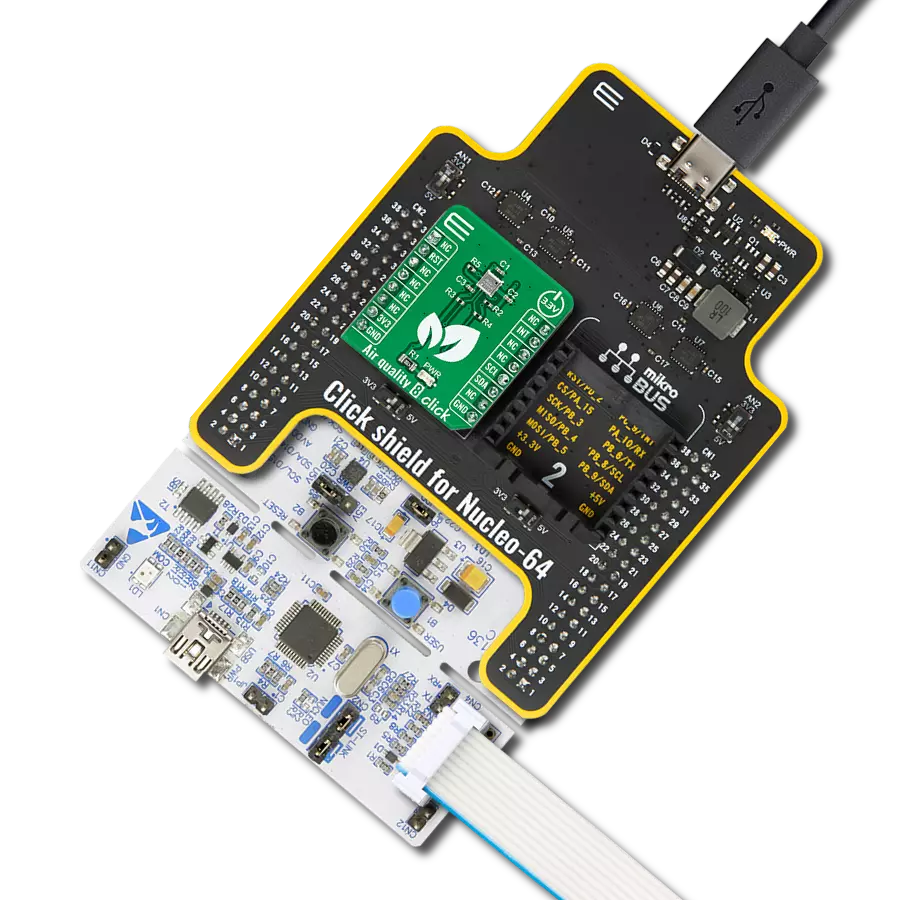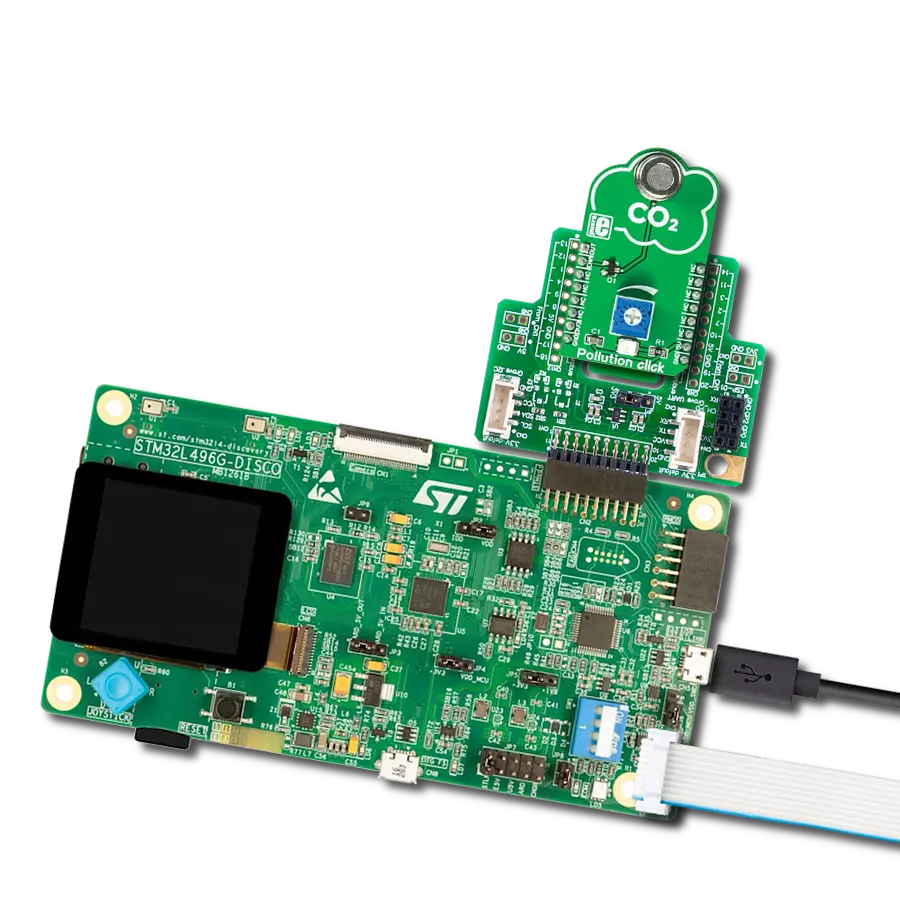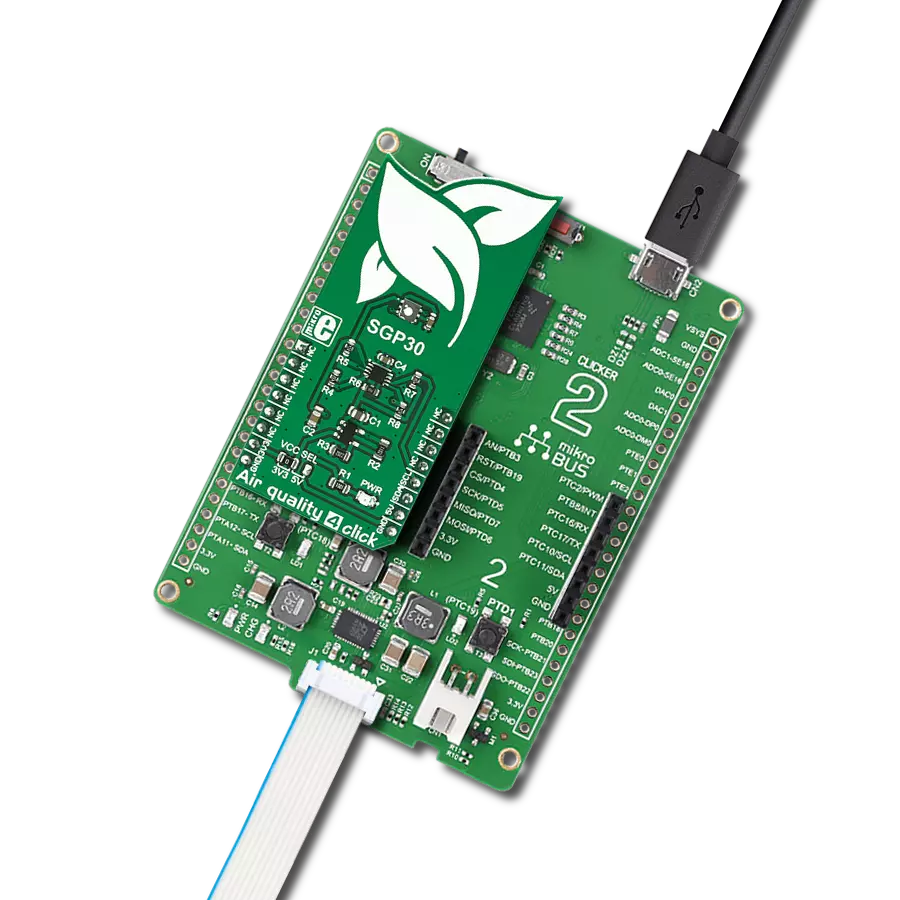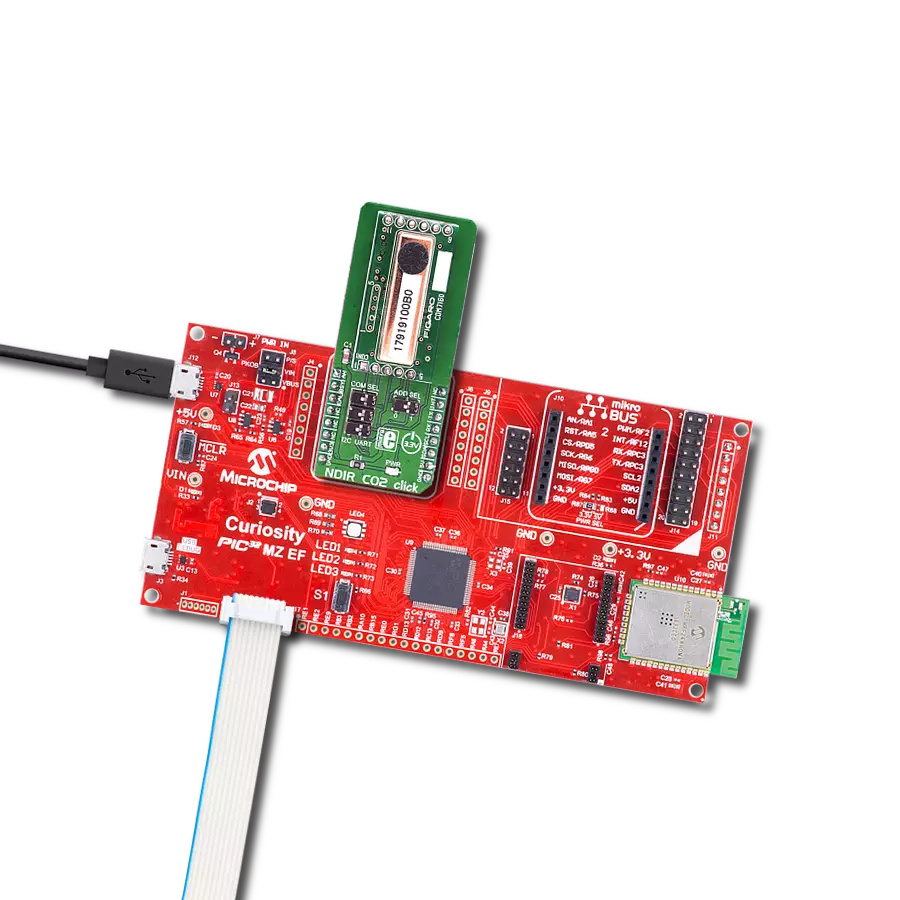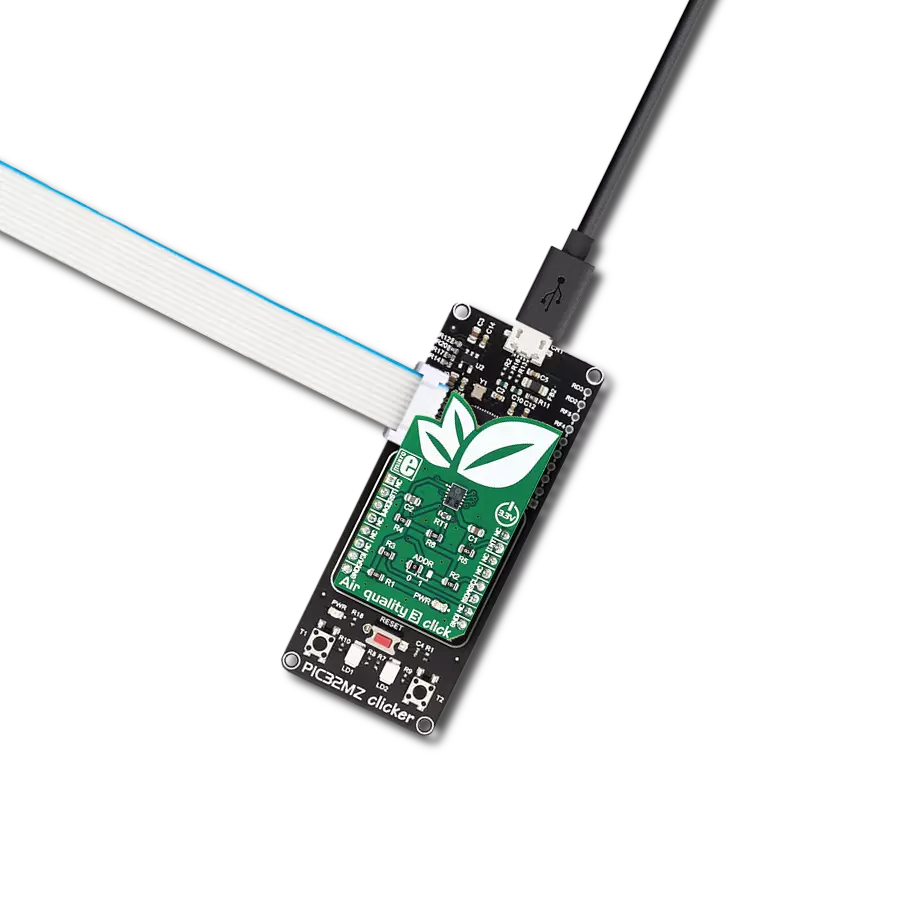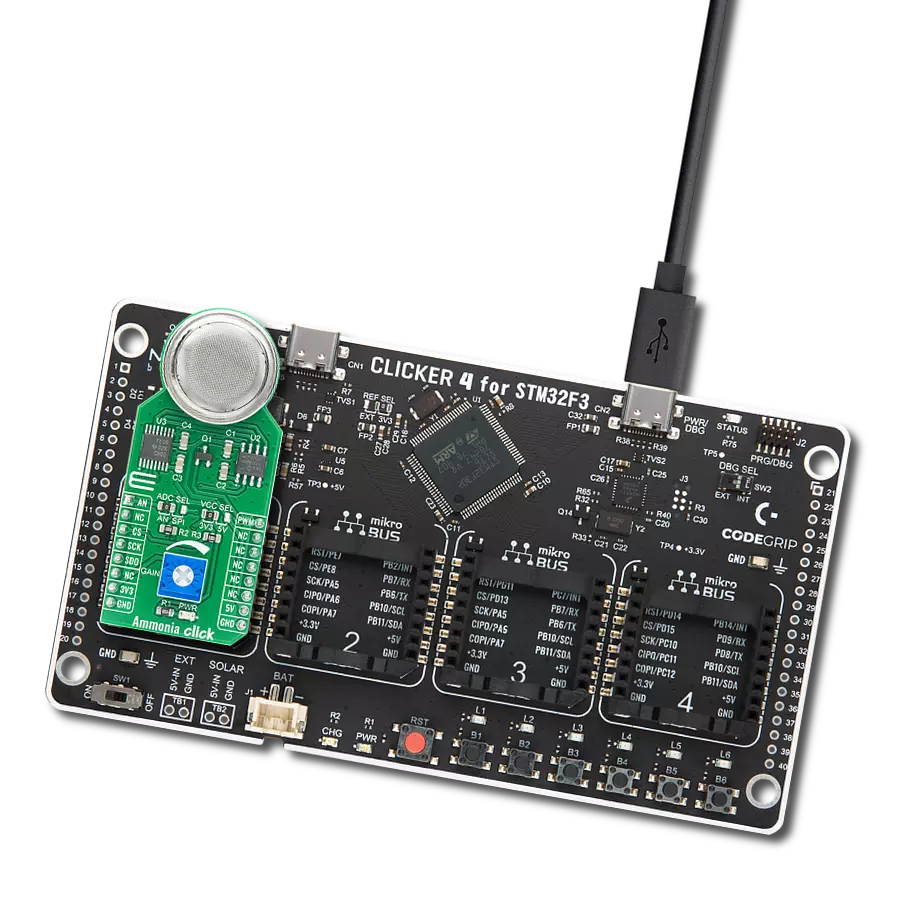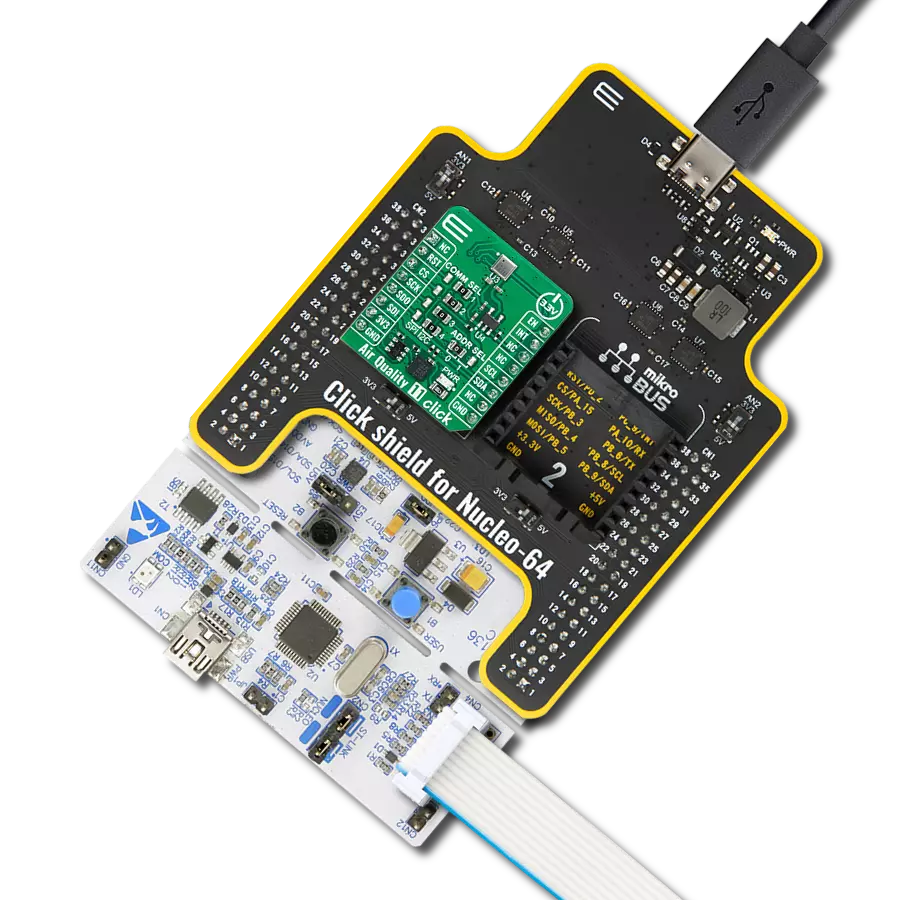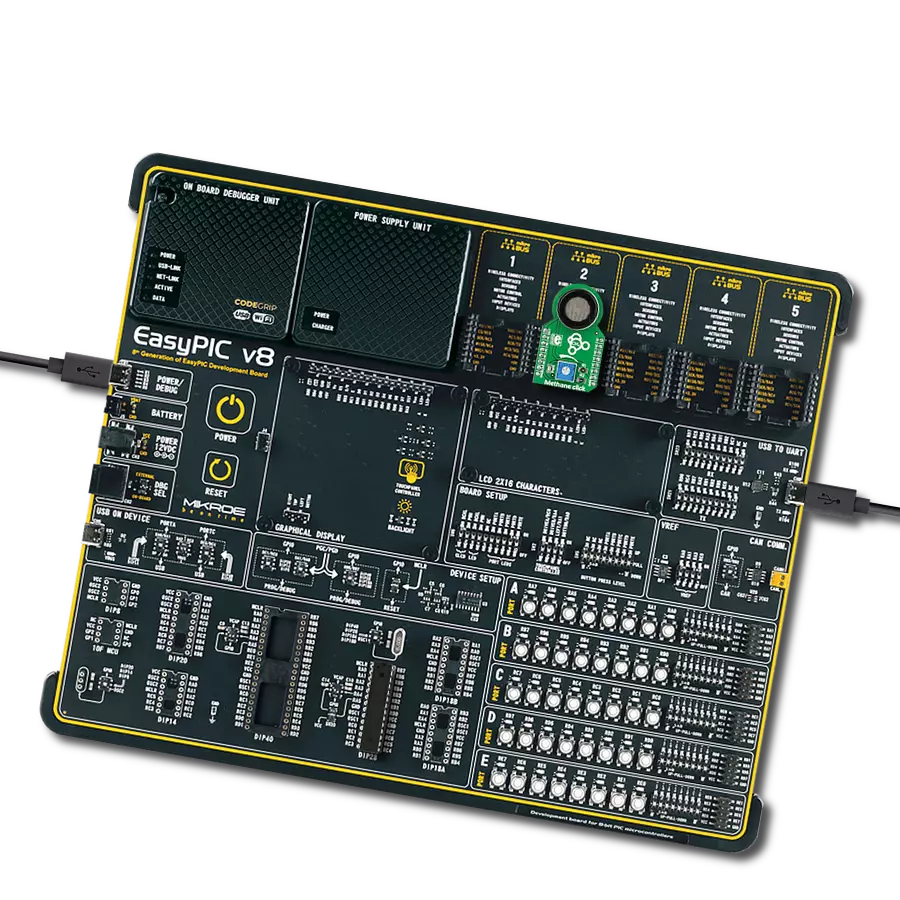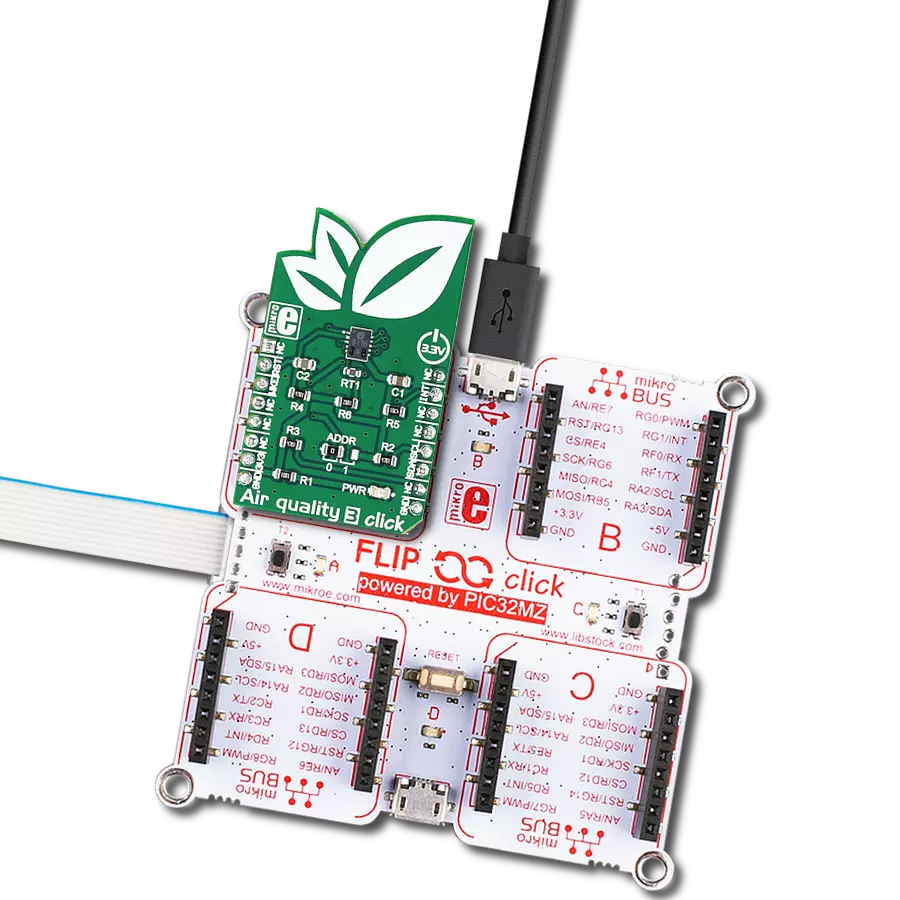Stay ahead in safeguarding health and well-being by measuring CO2 levels using our state-of-the-art solution.
A
A
Hardware Overview
How does it work?
CO2 3 Click is based on the XENSIV™ PASCO2V01BUMA1, the smallest CO2 sensor module from Infineon Technologies that uses photoacoustic spectroscopy technology to measure indoor air quality. The module consists of a gas measuring cell with an infrared (IR) emitter, a high-SNR microphone as the acoustic detector, and an XMC™ microcontroller for data processing, delivering exceptional accuracy, boasting a rate of ±30ppm ±3% of reading. Its diffuser port allows for efficient gas exchange while maintaining dust protection, and its acoustic isolation ensures highly accurate CO2 sensing information. Because of its superior features, this board makes an excellent choice for building automation, smart home appliances, and air quality monitoring, including air purifiers, thermostats, and HVAC systems. Its precise measurements can help optimize indoor air quality, improving human health, productivity, and comfort. As mentioned, the PASCO2V01BUMA1 overcomes the size, performance, and assembly challenges of existing CO2 sensor solutions by using photoacoustic spectroscopy (PAS). It uses pulses of light from an infrared source that pass through an optical filter explicitly tuned to the CO2 absorption wavelength. The CO2 molecules inside the measurement chamber absorb the filtered light, causing the molecules to shake and generate a pressure wave with each pulse, known as the photoacoustic effect. The sound is then detected by an acoustic detector optimized for low-frequency operation,
and the microcontroller converts the output into a CO2 concentration reading. This results in a highly accurate and reliable measurement of CO2 levels in real-time. All significant components of the XENSIV™ PASCO2V01BUMA1 CO2 module are developed in-house according to Infineon's high-quality standards, ensuring the highest quality and performance. The dedicated MCU runs advanced compensation algorithms to deliver direct and reliable ppm readouts of actual CO2 levels. The available configuration options, such as ABOC, pressure compensation, signal alarm, sample rate, and early measurement notification, make this board one of the most versatile plug-and-play CO2 solutions on the market. This Click board™ comes with a configurable host interface that allows communication with MCU using the selected interface. The PASCO2V01BUMA1 can communicate with MCU using the UART interface with commonly used UART RX and TX pins as its default communication protocol operating at 115200bps to transmit and exchange data with the host MCU or using the optional I2C interface. The I2C interface is compatible with the Fast-Mode, allowing a maximum frequency of 400kHz. Selection is made by positioning SMD jumpers marked COMM SEL to the appropriate position. All jumpers must be on the same side, or the Click board™ may become unresponsive. As a third option for communication with the MCU, users have a PWM interface controlled via the PWS pin of the mikroBUS™ socket. The PWS pin is first
asserted after the Power-On boot sequence (not after soft reset), and the level of the pin is checked. If a low level is detected, an internal interrupt routine configures the device into Continuous mode and starts a measurement sequence. At the end of each measurement sequence, the level of this pin is polled. If it is high, the device is configured back to Idle mode. The PWO pin, routed to the AN pin of the mikroBUS™ socket by default, offers the possibility to read out the CO2 concentration by delivering a PWM signal whose timing information contains the CO2 concentration value. At the end of each measurement sequence, the device updates the PWM timing with the measured CO2 concentration. This board also possesses an additional interrupt alert signal, routed on the INT pin of the mikroBUS™ socket, to provide a notification of CO2 measurements that violate programmed thresholds. This Click board™ can only be operated with a 3.3V logic voltage level. Since the sensor module for proper operation requires a voltage level of 12V, this Click board™ also features the TLV61046A, a voltage boost converter to generate a stable 12V supply. The board must perform appropriate logic voltage level conversion before using MCUs with different logic levels. However, the Click board™ comes equipped with a library containing functions and an example code that can be used as a reference for further development.
Features overview
Development board
Nucleo-64 with STM32L073RZ MCU offers a cost-effective and adaptable platform for developers to explore new ideas and prototype their designs. This board harnesses the versatility of the STM32 microcontroller, enabling users to select the optimal balance of performance and power consumption for their projects. It accommodates the STM32 microcontroller in the LQFP64 package and includes essential components such as a user LED, which doubles as an ARDUINO® signal, alongside user and reset push-buttons, and a 32.768kHz crystal oscillator for precise timing operations. Designed with expansion and flexibility in mind, the Nucleo-64 board features an ARDUINO® Uno V3 expansion connector and ST morpho extension pin
headers, granting complete access to the STM32's I/Os for comprehensive project integration. Power supply options are adaptable, supporting ST-LINK USB VBUS or external power sources, ensuring adaptability in various development environments. The board also has an on-board ST-LINK debugger/programmer with USB re-enumeration capability, simplifying the programming and debugging process. Moreover, the board is designed to simplify advanced development with its external SMPS for efficient Vcore logic supply, support for USB Device full speed or USB SNK/UFP full speed, and built-in cryptographic features, enhancing both the power efficiency and security of projects. Additional connectivity is
provided through dedicated connectors for external SMPS experimentation, a USB connector for the ST-LINK, and a MIPI® debug connector, expanding the possibilities for hardware interfacing and experimentation. Developers will find extensive support through comprehensive free software libraries and examples, courtesy of the STM32Cube MCU Package. This, combined with compatibility with a wide array of Integrated Development Environments (IDEs), including IAR Embedded Workbench®, MDK-ARM, and STM32CubeIDE, ensures a smooth and efficient development experience, allowing users to fully leverage the capabilities of the Nucleo-64 board in their projects.
Microcontroller Overview
MCU Card / MCU
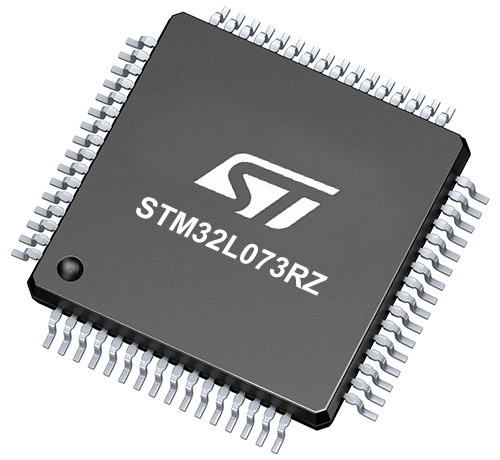
Architecture
ARM Cortex-M0
MCU Memory (KB)
192
Silicon Vendor
STMicroelectronics
Pin count
64
RAM (Bytes)
20480
You complete me!
Accessories
Click Shield for Nucleo-64 comes equipped with two proprietary mikroBUS™ sockets, allowing all the Click board™ devices to be interfaced with the STM32 Nucleo-64 board with no effort. This way, Mikroe allows its users to add any functionality from our ever-growing range of Click boards™, such as WiFi, GSM, GPS, Bluetooth, ZigBee, environmental sensors, LEDs, speech recognition, motor control, movement sensors, and many more. More than 1537 Click boards™, which can be stacked and integrated, are at your disposal. The STM32 Nucleo-64 boards are based on the microcontrollers in 64-pin packages, a 32-bit MCU with an ARM Cortex M4 processor operating at 84MHz, 512Kb Flash, and 96KB SRAM, divided into two regions where the top section represents the ST-Link/V2 debugger and programmer while the bottom section of the board is an actual development board. These boards are controlled and powered conveniently through a USB connection to program and efficiently debug the Nucleo-64 board out of the box, with an additional USB cable connected to the USB mini port on the board. Most of the STM32 microcontroller pins are brought to the IO pins on the left and right edge of the board, which are then connected to two existing mikroBUS™ sockets. This Click Shield also has several switches that perform functions such as selecting the logic levels of analog signals on mikroBUS™ sockets and selecting logic voltage levels of the mikroBUS™ sockets themselves. Besides, the user is offered the possibility of using any Click board™ with the help of existing bidirectional level-shifting voltage translators, regardless of whether the Click board™ operates at a 3.3V or 5V logic voltage level. Once you connect the STM32 Nucleo-64 board with our Click Shield for Nucleo-64, you can access hundreds of Click boards™, working with 3.3V or 5V logic voltage levels.
Used MCU Pins
mikroBUS™ mapper
Take a closer look
Click board™ Schematic

Step by step
Project assembly
Software Support
Library Description
This library contains API for CO2 3 Click driver.
Key functions:
co23_get_co2_ppm- CO2 3 get CO2 concentration function.co23_set_meas_cfg- CO2 3 set measurement configuration function.co23_set_pressure_ref- CO2 3 set reference pressure function.
Open Source
Code example
The complete application code and a ready-to-use project are available through the NECTO Studio Package Manager for direct installation in the NECTO Studio. The application code can also be found on the MIKROE GitHub account.
/*!
* @file main.c
* @brief CO2 3 Click example
*
* # Description
* This library contains API for CO2 3 Click driver.
* This driver provides the functions for sensor configuration
* and reading the CO2 gas concentration in the air.
*
* The demo application is composed of two sections :
*
* ## Application Init
* The initialization of I2C or UART module, log UART, and additional pins.
* After the driver init, the app executes a default configuration.
*
* ## Application Task
* This example demonstrates the use of the CO2 3 Click board™.
* The device starts a single measurement sequence,
* measures and display air CO2 gas concentration (ppm).
* Results are being sent to the UART Terminal, where you can track their changes.
*
* @author Nenad Filipovic
*
*/
#include "board.h"
#include "log.h"
#include "co23.h"
static co23_t co23;
static log_t logger;
void application_init ( void )
{
log_cfg_t log_cfg; /**< Logger config object. */
co23_cfg_t co23_cfg; /**< Click config object. */
/**
* Logger initialization.
* Default baud rate: 115200
* Default log level: LOG_LEVEL_DEBUG
* @note If USB_UART_RX and USB_UART_TX
* are defined as HAL_PIN_NC, you will
* need to define them manually for log to work.
* See @b LOG_MAP_USB_UART macro definition for detailed explanation.
*/
LOG_MAP_USB_UART( log_cfg );
log_init( &logger, &log_cfg );
log_info( &logger, " Application Init " );
// Click initialization.
co23_cfg_setup( &co23_cfg );
CO23_MAP_MIKROBUS( co23_cfg, MIKROBUS_1 );
if ( I2C_MASTER_ERROR == co23_init( &co23, &co23_cfg ) )
{
log_error( &logger, " Communication init." );
for ( ; ; );
}
Delay_ms ( 100 );
if ( CO23_ERROR == co23_default_cfg ( &co23 ) )
{
log_error( &logger, " Default configuration." );
for ( ; ; );
}
Delay_ms ( 100 );
log_info( &logger, " Application Task " );
log_printf( &logger, "-----------------------\r\n" );
Delay_ms ( 100 );
}
void application_task ( void )
{
co23_meas_cfg_t meas_cfg;
meas_cfg.op_mode = CO23_OP_MODE_SINGLE;
co23_set_meas_cfg( &co23, meas_cfg );
Delay_ms ( 1000 );
uint16_t co2_ppm = 0;
co23_get_co2_ppm( &co23, &co2_ppm );
log_printf( &logger, " CO2: %d ppm\r\n", co2_ppm );
log_printf( &logger, "-----------------------\r\n" );
Delay_ms ( 100 );
}
int main ( void )
{
/* Do not remove this line or clock might not be set correctly. */
#ifdef PREINIT_SUPPORTED
preinit();
#endif
application_init( );
for ( ; ; )
{
application_task( );
}
return 0;
}
// ------------------------------------------------------------------------ END
Additional Support
Resources
Category:Gas
